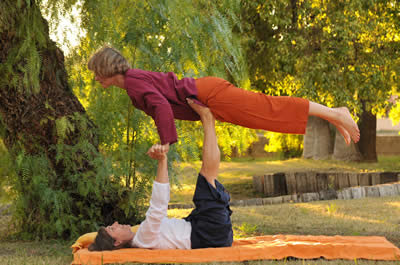
In Sanskrit, the word “pose” is “asana” (pronounced as “ah-sah-nah”).
Ancient yogis studied human body and then developed various yoga asanas so that each and every part of our body gets benefits from yoga poses. The yoga poses not only give us health benefits but also make us more aware of our body, mind, and environment.
It is however advised that while beginning yoga exercises, one must have a cool mind and experiment with the poses as per one’s comfort and convenience. The benefits of yoga exercises will be noticed faster if one has a playful mind and also the feeling of frustration and competitiveness will not enter the mind. The word of caution one must keep in mind while practicing yoga exercises, is that there must not be any feeling of discomfort or pain.
Important things to keep in mind during yoga practice:
Ancient yogis studied human body and then developed various yoga asanas so that each and every part of our body gets benefits from yoga poses. The yoga poses not only give us health benefits but also make us more aware of our body, mind, and environment.
It is however advised that while beginning yoga exercises, one must have a cool mind and experiment with the poses as per one’s comfort and convenience. The benefits of yoga exercises will be noticed faster if one has a playful mind and also the feeling of frustration and competitiveness will not enter the mind. The word of caution one must keep in mind while practicing yoga exercises, is that there must not be any feeling of discomfort or pain.
Important things to keep in mind during yoga practice:
- Never hold your breathe during a pose.
- Do not force or strain your breath.
- Whenever you notice Labored breathing, come out of the pose slightly as it is an indication that you’re working too hard.
- The rule of thumb is that, one can hold for three full breaths through most yoga poses. You must hold it longer only if your body says that you are comfortable in the pose, and if the body shows symptoms that you are uncomfortable, you should come out of the pose immediately.
Types of Yoga Poses
Seated poses
Seated poses
- Seated yoga poses are especially beneficial if practiced for breathing exercises and relaxation or meditation techniques.
- Seated poses generally advised to be used as a warm up or as a starting point for other poses.
- Performing seated poses can help improve your posture and open your hips.
Standing poses
- Standing yoga poses are often used as warm up or as a starting point for other poses.
- Standing poses are beneficial for strengthening your legs, opening your hips and improving your sense of balance.
Inversions
- Yoga experts advice Inversion yoga poses because it helps to improve your blood circulation quiet your mind and improve your overall health.
- Inversions are also believed to reverse the ageing process and reduce the effect of the gravity on your body.
Relaxation and restorative poses
- Relaxation or restorative yoga poses are more beneficial if performed at the end of each yoga practice.
- The body and mind get more relaxed at this time and the energy released by the poses in your practice is moved freely throughout your body.
Counter poses
- A counter pose is a yoga pose that stretches your spine in the opposite direction from a previous pose or returns your spine to a neutral position.
Twists
- Twists are generally advised to stretch and strengthen your back and abdominal muscles, increase the flexibility of your spine and improve your circulation.
- As the body is twisted and released, a fresh flow of blood moves in the body thereby improving the functioning of your internal organs.
Balancing poses
- Balancing yoga poses are great for improving your balance and coordination as well as developing your ability to remain grounded in a pose.
- Keeping your body balanced encourages you to focus, quiet and balance your mind.
Forward bends
- Forward bends stretch the entire back of your body, especially your hamstrings.
- Forward bends especially beneficial to release tension, calm your mind and soothe your nervous system.
- Similar to back bends, forward bends help keep your spine strong and supple.
Back bends
- A great challenge for any yoga performer is to perform back bends successfully.
- Bending backward helps strength your back and keep your spine strong and supple.
- Back bends also open the front of your body, especially your chest.



















